Oil prices experienced a slight uptick on Thursday, reversing a significant sell-off triggered by the recent U.S. presidential election. In the wake of the election results, concerns over supply constraints were raised, particularly with the impending presidency of Donald Trump, alongside a threat from Hurricane Rafael looming over the Gulf Coast. Despite the strength of the U.S. dollar and rising inventories of crude oil, these factors proved insufficient to mitigate the worries surrounding potential supply disruptions. Brent crude futures rose by 26 cents, marking a 0.35% increase to $75.18 per barrel, while U.S. West Texas Intermediate (WTI) crude saw a 16-cent or 0.22% rise, reaching $71.85 per barrel.
Initially reacting to Trump’s election, oil prices suffered a sharp decline, dropping over $2 as the U.S. dollar surged to its peak since September 2022. However, as the trading session progressed, losses in oil markets were curtailed. By the end of Wednesday, Brent crude settled down just 61 cents, while WTI recorded a smaller loss of 30 cents. Market analysts highlighted that the looming threat of renewed sanctions against Iranian and Venezuelan oil supplies under Trump’s administration, along with potential disruption from Hurricane Rafael, outweighed the post-election effects of a strengthened dollar and higher crude oil inventories.
Analysts suggest that Trump is likely to reinstate his “maximum pressure policy” concerning Iran, which could potentially lead to a reduction in supply by as much as 1 million barrels per day. However, they also note the difficulties involved in entirely halting the flow of Iranian oil to markets like China, which has shown resilience in purchasing Iranian oil despite sanctions. Trump’s previous term saw implementation of stringent sanctions on Venezuelan oil, with the recent Biden administration rolling back some measures before reinstating them. This history underscores the anticipated challenges faced by oil supply should Trump’s policies be reintroduced.
Amidst these geopolitical tensions, the weather has also become a significant factor impacting production in the Gulf region. Hurricane Rafael escalated to a category 3 hurricane as of Wednesday, prompting precautionary measures which resulted in a shutdown of about 17% of U.S. crude oil production—equating to approximately 304,418 barrels per day. The response to the hurricane highlights the vulnerability of oil supply chains to natural disasters, further complicating the market’s outlook in the context of shifting political winds.
On the inventory front, the U.S. Energy Information Administration revealed that crude inventories rose by 2.1 million barrels to reach 427.7 million barrels in the week ending November 1. This increase was notably above the anticipated rise of 1.1 million barrels. The climb in inventories signals a complex interplay between supply and demand, further influencing trader sentiment as the market grapples with both immediate supply concerns and broader economic conditions following the election.
In summary, the oil market is navigating through a turbulent phase characterized by geopolitical uncertainty surrounding U.S. foreign policy under a potential Trump presidency, adamant supply outlooks influenced by hurricane activity, and the recent shift in oil inventories. As analysts continue monitoring these developments, the stabilization of oil prices will depend heavily on how these various factors play out in the coming weeks and months, particularly regarding supply interruptions from OPEC nations and production impacts stemming from severe weather events.

